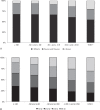Serum 25-hydroxyvitamin D level is associated with myopia in the Korea national health and nutrition examination survey
- PMID: 27861336
- PMCID: PMC5120893
- DOI: 10.1097/MD.0000000000005012
Serum 25-hydroxyvitamin D level is associated with myopia in the Korea national health and nutrition examination survey
Abstract
The aim of this article was to assess the associations of serum 25-hydroxyvitamin D [25(OH)D] and daily sun exposure time with myopia in Korean adults.This study is based on the Korea National Health and Nutrition Examination Survey (KNHANES) of Korean adults in 2010-2012; multiple logistic regression analyses were performed to examine the associations of serum 25(OH)D levels and daily sun exposure time with myopia, defined as spherical equivalent ≤-0.5D, after adjustment for age, sex, household income, body mass index (BMI), exercise, intraocular pressure (IOP), and education level. Also, multiple linear regression analyses were performed to examine the relationship between serum 25(OH)D levels with spherical equivalent after adjustment for daily sun exposure time in addition to the confounding factors above.Between the nonmyopic and myopic groups, spherical equivalent, age, IOP, BMI, waist circumference, education level, household income, and area of residence differed significantly (all P < 0.05). Compared with subjects with daily sun exposure time <2 hour, subjects with sun exposure time ≥2 to <5 hour, and those with sun exposure time ≥5 hour had significantly less myopia (P < 0.001). In addition, compared with subjects were categorized into quartiles of serum 25(OH)D, the higher quartiles had gradually lower prevalences of myopia after adjustment for confounding factors (P < 0.001). In multiple linear regression analyses, spherical equivalent was significantly associated with serum 25(OH)D concentration after adjustment for confounding factors (P = 0.002).Low serum 25(OH)D levels and shorter daily sun exposure time may be independently associated with a high prevalence of myopia in Korean adults. These data suggest a direct role for vitamin D in the development of myopia.
Conflict of interest statement
The authors report no conflicts of interest.
Figures


References
-
- Saw SM, Katz J, Schein OD, et al. Epidemiology of myopia. Epidemiol Rev 1996; 18:175–187. - PubMed
-
- Wong TY, Foster PJ, Hee J, et al. Prevalence and risk factors for refractive errors in adult Chinese in Singapore. Invest Ophthalmol Vis Sci 2000; 41:2486–2494. - PubMed
-
- Lin LL, Shih YF, Hsiao CK, et al. Epidemiologic study of the prevalence and severity of myopia among schoolchildren in Taiwan in 2000. J Formos Med Assoc 2001; 100:684–691. - PubMed
-
- Shimizu N, Nomura H, Ando F, et al. Refractive errors and factors associated with myopia in an adult Japanese population. Jpn J Ophthalmol 2003; 47:6–12. - PubMed
-
- Lee JH, Jee D, Kwon JW, et al. Prevalence and risk factors for myopia in a rural Korean population. Invest Ophthalmol Vis Sci 2013; 54:5466–5471. - PubMed
MeSH terms
Substances
LinkOut - more resources
Full Text Sources
Other Literature Sources
Medical

